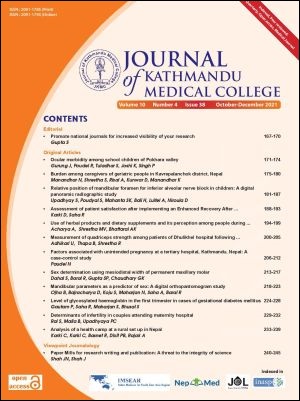Level of glycosylated haemoglobin in the first trimester in cases of gestational diabetes mellitus
DOI:
https://doi.org/10.3126/jkmc.v10i4.43867Keywords:
Fasting blood glucose, Gestational diabetes mellitus, Glycosylated haemoglobin, Oral glucose tolerance test, PostprandialAbstract
Background: Glycosylated haemoglobin (HbA1c) level during early pregnancy has been proposed as a predictor of gestational diabetes mellitus (GDM).
Objectives: To determine the mean value of first trimester’s glycosylated haemoglobin (HbA1c) in gestational diabetes mellitus cases.
Methods: An analytical cross-sectional study was conducted among GDM cases at the Obstetrics and Gynaecology Department of Kathmandu Medical College after ethical clearance. Purposive sampling was done to enrol 102 cases that presented over a period of August 2020 to January 2021. First trimester HbA1c levels were recorded. The HbA1c values were grouped into two taking 5.7% as a cut-off which is an established threshold for prediabetes in a normal population.
Results: The mean age of participants was 28.74 ± 4.1 years and mean body mass index was 29.13 ± 2.73 kg/m2. Mean value of HbA1c was 5.52 ± 0.44%. Mean value of fasting blood glucose and postprandial glucose after oral glucose tolerance test (OGTT) was 102.25 ± 7.36 mg/dl and 167.55 ± 10.91 mg/dl respectively. Out of total participants, only 40 (39.21%) had HbA1c value more than 5.7% while 62 (60.78%) had HbA1c value less than 5.7%. There was weak positive correlation between HbA1c and Fasting Blood Glucose (Pearson’s correlation coefficient r = 0.13). Similarly, correlation between HbA1c and blood sugar after OGTT (r = 0.17) was also insignificant.
Conclusion: This study concluded that the HbA1c value of first trimester is not very different than normal population. Hence, diabetic range of HbA1c value in first trimester is useful in diagnosing overt diabetes.
Downloads
Downloads
Published
How to Cite
Issue
Section
License
Copyright © Journal of Kathmandu Medical College
The ideas and opinions expressed by authors or articles summarized, quoted, or published in full text in this journal represent only the opinions of the authors and do not necessarily reflect the official policy of Journal of Kathmandu Medical College or the institute with which the author(s) is/are affiliated, unless so specified.
Authors convey all copyright ownership, including any and all rights incidental thereto, exclusively to JKMC, in the event that such work is published by JKMC. JKMC shall own the work, including 1) copyright; 2) the right to grant permission to republish the article in whole or in part, with or without fee; 3) the right to produce preprints or reprints and translate into languages other than English for sale or free distribution; and 4) the right to republish the work in a collection of articles in any other mechanical or electronic format.




